
Olivine Gemstone: Properties, Meanings, Value & More
Olivine describes a group of minerals known for their often yellow-green color and presence in outer space. Some scientists even suggest that the moon’s mantle contains olivine! Here on Earth, olivine is best known for the popular gemstone variety peridot.
Where did olivine get its name? Just look at its color! Olivine is named for its varying shades of yellow and olive green.
Curious to know more about this intergalactic gem? Lucky for you, Gem Rock Auctions is your trusted source for all things gemstones. We’ve put together a complete run-down on olivine varieties, prices, uses, and more.
Keep reading to learn all there is to know about olivine!
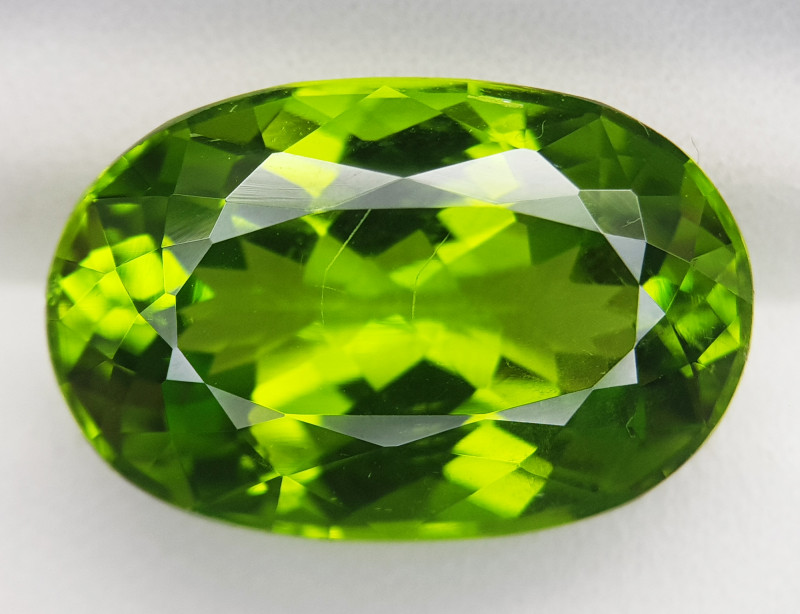
About Olivine Gemstones
Olivine (pronounced AW-luh-veen) is an abundant silicate found inside the earth’s mantle. It’s also a well-known space gemstone, as many meteorites (specifically pallasites) contain olivine crystals.
The color of olivine is typically yellowish-green, but can also contain vivid yellows, greens, oranges, and browns. The gemstone
What is an olivine crystal? Olivine is widely known as the parent of peridot (pronounced PAIR-uh-doe), a popular green gemstone. Also called chrysolite, it’s one of the only gemstones defined by its consistent coloring — a yellowish, olive-green hue.
Is olivine a precious gem? Olivine is abundant in the earth, while peridot is quite rare; however, it’s still considered a semi-precious gemstone.
Historically, peridot was a September birthstone. In 1912, peridot was made a secondary alternative to sardonyx as an August birthstone. The National Association of Goldsmiths made peridot the primary August birthstone in 1937.
Today, astrologers recommend olivine as a lucky Virgo or Libra birthstone.
Peridot is also a milestone gem for the 16th wedding anniversary, in which the olivine gemstone’s meaning is one of unwavering love and admiration.
Wait — does that mean that olivine is the same as peridot? Yes and no.
Olivine vs. Peridot
If you’re wondering what the difference is between olivine and peridot, it’s nothing major. While many in the gem industry refer to the two interchangeably, “olivine” refers to the mineral class, whereas “peridot” is the most popular gem variety of olivine.
Let’s expand on the olivine mineral class.

Olivine Specifications & Characteristics
“Olivine” technically refers to a group of orthorhombic silicate (orthosilicate) minerals, not one individual mineral.
The olivine group formula is M2SiO4 where M can be calcium, iron, manganese, nickel, and/or magnesium.
Here’s a full list of olivine group minerals:
Forsterite: Mg2SiO4; Magnesium silicate
Fayalite: Fe2+2SiO4 or Fe2SiO4; Ferrous iron silicate; AKA Fe-rich olivine or Iron-chrysolite
Tephroite: Mn2+2SiO4 or Mn2SiO4; Manganese silicate; AKA Mangan-peridot
Kirschsteinite: CaFe2+SiO4; Calcium ferrous iron silicate
Monticellite: CaMgSiO4; Calcium magnesium silicate
Calcio-Olivine: Ca2SiO4; Calcium silicate
Glaucochroite: CaMn2+SiO4; Calcium manganese silicate
Kirschsteinite: CaFe2+SiO4; Calcium ferrous iron silicate
Laihunite: (Fe2+0.50.5)Fe3+[SiO4] or (Fe3+,Fe2+,)2(SiO4); Ferrous & ferric iron silicate
Liebenbergite: Ni2SiO4; Nickel silicate
The main minerals in the “olivine series” are forsterite and fayalite.
Many olivines fall between these compositions. Nowadays, mineralogists will write the formulas with the ratio of magnesium to iron — e.g. Fo90 for a mineral that’s 90% forsterite (magnesium) and 10% fayalite (iron). In the past, various names were given for specific ratios, like hortonolite, hyalosiderite, and ferrohortonolite.
Tephroite is another important member.
The popular gemstone variety of olivine, peridot, is often cited as a variety of forsterite, but its composition ranges along the series from magnesium-dominant forsterite to iron-dominant fayalite. Usually, peridot’s composition is closer to forsterite, though.
Typically, olivine minerals appear in dense, fractured masses with rounded grains and glass-like luster. High-quality olivines like peridot or tephroite are sought-after as rough crystals, which are usually short and prismatic.
While olivine is one of the most common minerals in the earth by volume, large specimens of gem-quality peridot are hard to come by.
Olivine Mineral Properties
Below, we’ll list the properties of the main olivine minerals, specifying the type of olivine if they differ:
Mohs hardness: 6 (tephroite); 6.5 (fayalite); 7 (forsterite)
Color: Brown, reddish-brown, flesh-red, blue-green, green, olive, gray (tephroite); Olive green, greenish-yellow, yellow, amber brown, brown (fayalite); Green, pale yellow, white (forsterite)
Crystal structure: Orthorhombic
Luster: Vitreous (forsterite); Vitreous to greasy/oily (tephroite & fayalite)
Transparency: Translucent to transparent
Refractive index: 1.770-1.825 (tephroite); 1.731-1.879 (fayalite); 1.635-1.772 (forsterite)
Density: 3.87-4.12 (tephroite); 4.39 (fayalite); 3.22-3.27 (forsterite)
Cleavage: Distinct/Good on {010}, imperfect on {001} (tephroite); Indistinct on {010} and {100} (fayalite); Perfect on {010}, indistinct/imperfect on {100}
Fracture: Conchoidal or irregular/uneven (tephroite); Conchoidal (fayalite & forsterite)
Streak: White; Pale gray (tephroite)
Luminescence: None
Pleochroism: Weak in brownish-red to reddish to greenish-blue (tephroite); Visible in pale yellow to orange-yellow/reddish-brown OR greenish-yellow to pale yellow to pale amber (fayalite); Weak in green to yellow-green (peridot / fayalite-forsterite); None (forsterite)
Birefringence: 0.047 (tephroite); 0.035 (fayalite); 0.052 (forsterite)
Dispersion: Weak (<0.020) to moderate (0.020)
Optical effects: Rarely color-changing (tephroite); Rarely 4- to 6-rayed asterism or chatoyancy (peridot / forsterite-fayalite)
 Pictured above: Fayalite with tridymite balls on cristobalite from Coso Hot Springs, Coso District (New Coso District), Inyo Co., California, USA | Image credit: Didier Descouens, CC-BY-SA-4.0
Pictured above: Fayalite with tridymite balls on cristobalite from Coso Hot Springs, Coso District (New Coso District), Inyo Co., California, USA | Image credit: Didier Descouens, CC-BY-SA-4.0
Types of Olivine Gemstones
Despite its many varieties, only a few olivine minerals occur as gem-quality material.
Varieties of olivine used as gemstones include:
Peridot: Transparent olive-green variety of forsterite-fayalite that’s the most well-known type in the gem world
Tephroite: Rare gemstone variety known for being reddish or gray but sometimes color-changing, shifting from bluish-gray or grayish-green to reddish-brown in daylight and incandescent light, respectively
You might also see some names used for olivine “varieties” that are generally not accepted among experts:
Chrysolite: Usually refers to a yellow or yellow-green form of olivine; Used synonymously with olivine or peridot
Dunite: Solid, grainy masses of olivine, typically classified as a rock
Olivinoid: An extraterrestrial form of olivine found in many meteorites
Additionally, there are plenty of misnomers out there; for instance, demantoid garnet being called “olivine” or peridot being called “evening emerald.”
To be fair, olivine hasn’t always been called olivine.
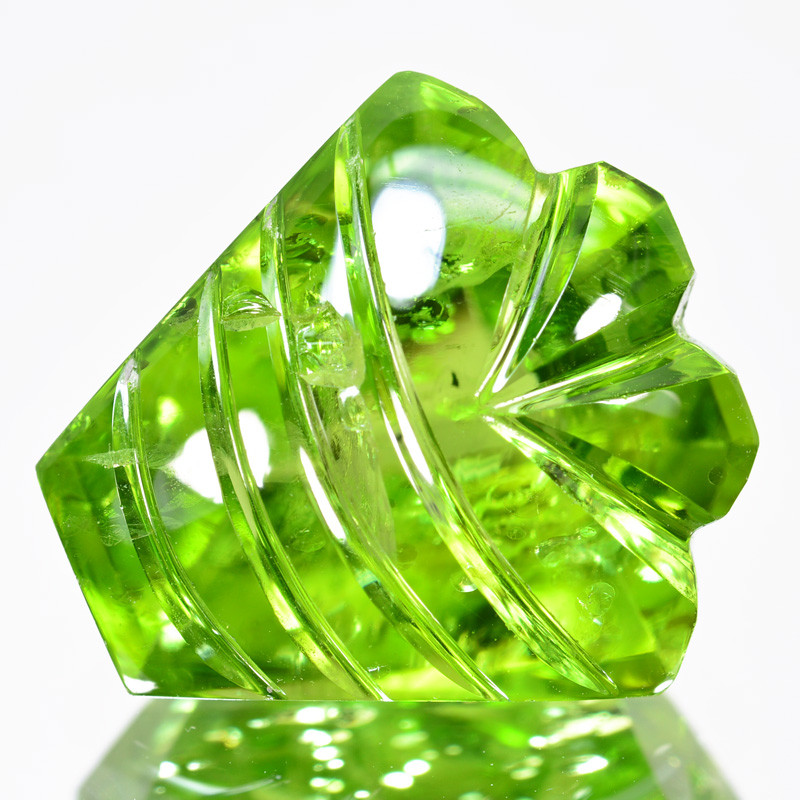
Olivine Meaning & History
Olivine’s history is pretty vast, so we’ll go over the most notable parts here, starting in ancient times.
You may know that the term “emerald” derives from the Ancient Greek smáragdos, meaning “green gem,” and that the term “beryl” comes from the Greek beryllos, meaning “precious blue-green color-of-sea-water stone.”
What you may not know is that some of the “smaragdos” and “beryllos” stones mentioned by 1st-century AD Roman scholar Pliny the Elder may have actually been forsterite.
But the most long-lasting misnomer for gem-quality olivine (peridot) was topazion or topaz. This name honors the earliest known source of green olivine: Topazios Island (present-day Zabargad or St. John's Island) off the coast of Egypt.
It wasn’t until the 1700s that the name “topaz” started being used for the topaz we know today, when olivine/peridot started its new name journey.
Modern Olivine Name Origins
The name “olivine” is simply derived from the Latin oliva, meaning “olive,” for its color.
The olivine group etymology is more complex, so we’ll break it down chronologically:
Chrysolite: First modern recorded term for any type of olivine; Used by Swedish chemist and mineralogist Johan Gottschalk Wallerius in 1747 but also by French chemist Balthasar Georges Sage in 1777 for what ended up being prehnite
Peridot Ordinaire: French for “ordinary peridot,” used in 1755 by French writer Antoine Joseph Dezallier d'Argenville
Gulgrön Topas: Swedish for “yellow-green topaz,” used in 1758 by Swedish mineralogist & chemist Axel Cronstedt
Chrysolite Ordinaire: French for “ordinary chrysolite,” used in 1772 by French mineralogist Jean-Baptiste Louis Romé de l'Isle
Olivine: New name for Wallerius’s chrysolite, used in 1789 by German geologist Abraham Gottlob Werner
Tephroite: Next type identified & named in 1823 by German geologist Johann Friedrich August Breithaupt
Hyalosiderite: Name for iron-rich olivine given in 1823 by German geologist Friedrich Walchner
Forsterite: New name for magnesium-dominant olivine given by French mathematician & mineralogist Armand Lévy in 1824 to honor German mineral collector Adolarius Jacob Forster
Boltonite: Used in 1835 by American mineralogist Charles Upham Shepard for green, granular forsterite variety found in Bolton, Massachusetts, USA
Fayalite: Named by German chemist Christian Gottlieb Gmelin in 1840 after the type locality, Fayal Island in Portugal
Glinkit: Used in 1847 by Russian mineralogist H. Romanovski
Talc and Olivine Group: Term used in 1859 by Hemy C. Salmon for the mineral group
Chrysolite Group: Name established in 1868 by American mineralogists James Dwight Dana and George Jarvis Bush, continued in 1892 by Edward Salisbury Dana
Are there any metaphysical properties or beliefs associated with olivine? Absolutely! In fact, they go back centuries.
 Pictured above: Basalt rock with olivine crystals in Hawaii | Image credit: incidencematrix on Flickr, CC-BY-SA-2.0
Pictured above: Basalt rock with olivine crystals in Hawaii | Image credit: incidencematrix on Flickr, CC-BY-SA-2.0
Ancient Beliefs About Olivine
Ancient texts suggest that olivine gemstones, called topaz back then, were mined as early as 1500 B.C.
In those times, Egypt was the go-to source for peridot. They dubbed it the “Gem of the Sun” and believed it helped ward off dark spirits. Ancient priests would adorn cups with peridot for communion with their Nature Gods, and Pharaohs would often use it in their talismans. Some historians believe Cleopatra’s famous emerald jewelry collection was actually peridot!
Peridot in its Hebrew name, pitdah, is referenced many times in the Christian Bible. At that time, it was believed to contain the power of nature. The famous High Priest’s Breastplate referenced in Exodus — believed to inspire birthstones — contained a pitdah as one of its twelve gems.
In discussing the value of wisdom, the book of Job (chapter 28, verse 19) states that:
“Precious peridot from Ethiopia cannot be exchanged for it. It’s worth more than the purest gold.”
European soldiers during the Crusades collected olivine gems, bringing them back to adorn their religious robes and plates.
Peridot is woven into Hawaii’s ancient folklore, too! Its beautiful green hue, reminiscent of the tropics, is believed to symbolize the tears of the goddess of volcanoes & fire, Goddess Pele.
But how have ancient beliefs transferred to modern healing uses for olivine?
Olivine Healing Properties
As a primarily green healing stone, olivine has the rejuvenating and balancing properties of other green gemstones.
Physical Healing
In the olden days, powdered peridot was used as a medical remedy to treat asthma and excessive thirst in feverish patients. While it isn’t suspected to be toxic if ingested, its oral medicinal use has been mostly retired today.
Today, olivine is thought to act as a powerful sterilizer that helps release toxins. Crystal healers use it to strengthen the immune system, support metabolism, and boost skin health. Proponents suggest it may also help treat ulcers, strengthen the eyes, balance symptoms of bipolar disorders, and relieve symptoms of hypochondria.
Emotional Healing
Feeling green with envy? Some of the purported olivine crystal benefits include alleviating resentment, jealousy, spite, and bitterness. It is also believed to help ward off feelings of anxiety and irritation.
Its calming effects are also said to help you fall asleep. By placing peridot under a pillow or near your bed, it helps ease the mind from worrying or overthinking so you can blissfully slip into a peaceful slumber.
...but what does olivine crystal do spiritually?
Chakra Healing
As a chakra stone, peridot holds vibrations aligned to the solar plexus and heart chakras. Crystal healers use olivine gemstones to open, activate, and clear these chakras during balancing and natural healings.
How do you know if these chakras aren’t in alignment? A blocked heart chakra will manifest itself in feelings of fear, discontent, or even disease. A blocked solar plexus can cause you to feel anxious and unable to feel joy or bliss.
Olivine is used in jewelry intended to be worn close to these chakras. This helps open them up to the free-flowing energy of healthy Chi and provides the positive vibrations they need to stay open and healthy.
Spiritual Healing / Balancing Energy
Similar to the way it realigns your chakras, peridot can help shift the energy in your space. In Feng Shui, green symbolizes the color of wealth and abundance. Its yellowish-green hues are also strongly associated with sunlight and nature. When placed in certain areas of the home, it is believed to invite certain energies into your space.
So, where should you keep your olivine gemstones?
Xun Area: This area, or “gua” as it is referred to in Feng Shui, is associated with wealth, prosperity, and financial abundance. What many forget is that it’s also associated with self-worth, generosity, and spiritual abundance. Activate Xun by placing peridot in this area — typically located in the back, left corner of your home.
Zhen Area: Located in the middle, left section of your home, this gua is associated with family and new beginnings. Placing a green gem, like peridot, in this area can promote harmony and support for a fresh start.
What factors influence the pricing and valuation of olivine gemstones in the market?

Olivine Gemstone Properties
The value of gem-quality olivines depends on their color, cut, clarity, carat weight, and treatments.
Color
As the name suggests, olivine is typically an olive-green color. It can sometimes appear with shades of yellow, orange, and brown; brown hues often come from iron in the olivine oxidizing.
Pure green peridot gemstones are rare, with most of them appearing yellowish green. Having a lower iron content of 12-15% is ideal for creating the valuable green peridot color; more iron (closer to fayalite) means browner hues, which are less valuable.
Compared to emerald, olivine’s green can be brilliant but less intense.
Sometimes, other shades of olivine appear, like black olivine (found in Japan) caused by numerous magnetite and diopside inclusions. These are only valuable geologically, though.
Cut
The most valuable olivine gemstones are typically faceted, with cuts ranging from traditional faceted shapes to custom cuts. Because of olivine’s high birefringence, lapidarists (gem cutters) must orient the stone correctly when cutting it to avoid fuzzy reflections.
Lower quality olivine may be cut into cabochons, beads, or carvings.
The exceptions are chatoyant and asteriated (“cat’s eye” or “star,” respectively) olivines, which are very rare. These must be cut as cabochons to display their optical effect.
These effects come from inclusions.

Clarity
Clarity describes the degree of visible inclusions in a gem. Gem-quality olivine (peridot) has Type II colored gemstone clarity, meaning the highest-quality specimens don’t have visible inclusions but some minor visible inclusions are expected in most crystals.
Overall, fewer inclusions means higher value.
That said, genuine peridot will have some inclusions and internal fractures, especially larger stones. A perfectly clean peridot is usually an indication that it’s fake.
Common inclusions in olivine gemstones include:
Bubble-looking glass balls
Chromium spinel
Black chromite
Dark red pyrope garnet
Brown biotite grains
“Lily pad” inclusions (rounded, light-reflective fractures surrounding a crystal)
Liquid- and gas-filled inclusions resembling fried eggs
Dark inclusions, particularly in pale-colored olivine, are more detrimental to peridot’s value.
The one time inclusions can raise value? When thin, needle-like inclusions are arranged in parallel or perpendicular bundles, resulting in chatoyancy or asterism.
Carat Weight
Olivine gemstones vary in sizes from melee to faceted stones of 10 carats or more. Fine faceted stones of 300 carats or more are rare but do exist, like the 311.78-carat peridot in the Smithsonian Museum that holds the record as the largest peridot in the world.
The largest faceted peridot gems come from Myanmar, followed by Egypt and the Himalayas in Pakistan.
Price-per-carat rates increase significantly for faceted olivine gems over 5 carats, but the rates generally increase every 1-3 carats up.
The largest known rough, eye-clean olivine crystal is a 100+ carat crystal from Norway.
Treatments
Most olivine gemstones aren’t treated. Sometimes, peridot gems are oiled or fracture-filled with wax to improve their clarity, but this treatment isn’t stable or permanent so it could lower value.
Additionally, there have been instances of shady producers using metal-foiling to increase stability or coat paler stones.
How To Determine If Olivine is Real
The key to identifying an olivine gemstone is its high birefringence (0.035-0.052), inclusions (no matter how minor), and of course, notable shades of olive green. Its green luster also doesn’t change, regardless of light.
The best way to tell if a peridot is real is by examining the stone’s color under different types of light — artificial, bright, dim, and so forth. Real peridot should remain a shimmery green under all the lights.
Speaking of the real deal, how does natural olivine form?
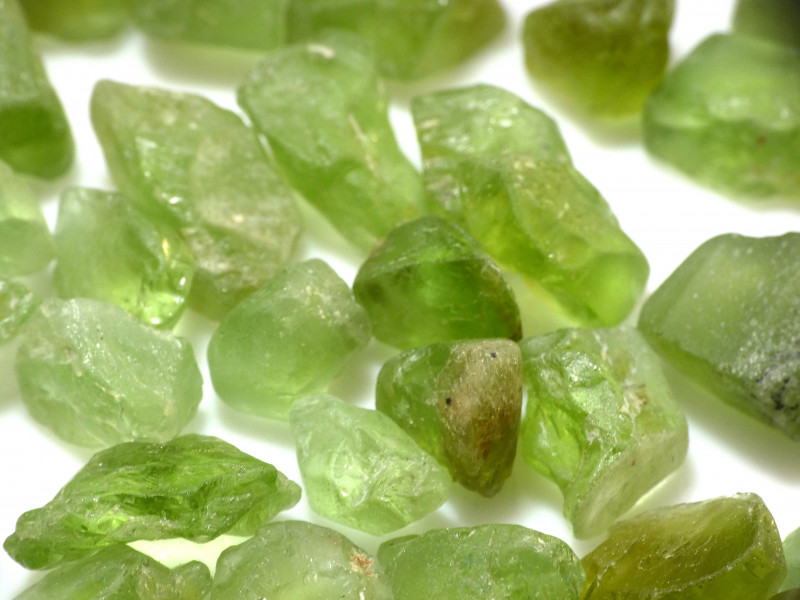
Olivine Formation & Sources
Olivine minerals are among the most common minerals on Earth, making up over half of the Earth’s upper mantle.
Unlike many gems, olivine (like diamond) forms much deeper in the earth’s mantle. Most olivines are located within tectonic plates and divergent plate boundaries.
As magnesium-rich and silica-poor magma cools, olivine crystals form and accumulate at the magma chamber’s base. Tectonic activity (like volcanic eruptions) brings olivine to the surface.
Typically, olivine minerals are found in igneous rocks like gabbros, basalts, peridotites, and dunites. They’re also found in high-magnesium, low-silica sedimentary rocks that underwent metamorphism.
Outside of Earth, olivine has been found on everything from other planets (Mars & Jupiter), to gas clouds, to asteroids, and meteorites with fascinating origins.
Olivine is also involved in the formation of many other minerals and rocks, like:
Serpentine: Olivine can transforms into serpentine due to metamorphism of ultramafic rocks like peridotite or dunite
Brucite: Magnesium-rich minerals like olivine can become brucite due to low-grade metamorphism (low pressure & low temperature), often in marble rocks
Millerite: Low-sulfur rocks predominantly made up of olivine (olivine cumulate rocks) can go through nucleation, pushing out the nickel and sulfur in the rocks to form millerite
Magnesite: Olivine that’s carbonated by high pressure, high temperatures, carbon dioxide, and water can become magnesite.
Talc: Olivine can become hydrated, turning into serpentine, then transform into talc and magnesite due to carbon dioxide.
Lava Rock: Olivine is one of the most common minerals found in lava rocks, alongside pyroxene, amphibole, and plagioclase feldspar.
Andesite: Olivine is a common mineral in andesites, along with quartz, magnetite, biotite, and sphene.
Next, where is olivine primarily found geographically, and what are its main mining locations?
Mining Locations
While gem-quality olivine got its start in Egypt’s Red Sea, they haven’t produced any for decades. Fortunately, it can be found in many places worldwide today — including the United States.
In the US, Arizona is the main source, notably containing the largest peridot deposit in the San Carlos Apache Indian Reservation; however, olivine gem material from Arizona rarely yields gems larger than 10-carats.
For larger sizes, Pyaung Gaung in the Mogok Stone Tract of Myanmar is unrivaled, frequently boasting olivine gem material of 10 carats and larger.
Besides Arizona and Myanmar, the other main suppliers of olivine gem rough are China and Pakistan.
China also supplies the distinguished Hunan peridot, a variety with top-tier clarity and transparency.
Additional sources of gem-quality olivine include:
Afghanistan
Australia
Brazil
Ethiopia
Kyrgyzstan
Norway
Sri Lanka
Vietnam
Zambia
For non-gemstone uses, Norway is the top dog, producing around 50% of the world’s industrial-grade olivine.
If you’d rather skip the mining and purchase peridot that’s already been cut, you’re going to want to prep your budget. Let’s look at what the price of olivine is and how its value is determined.
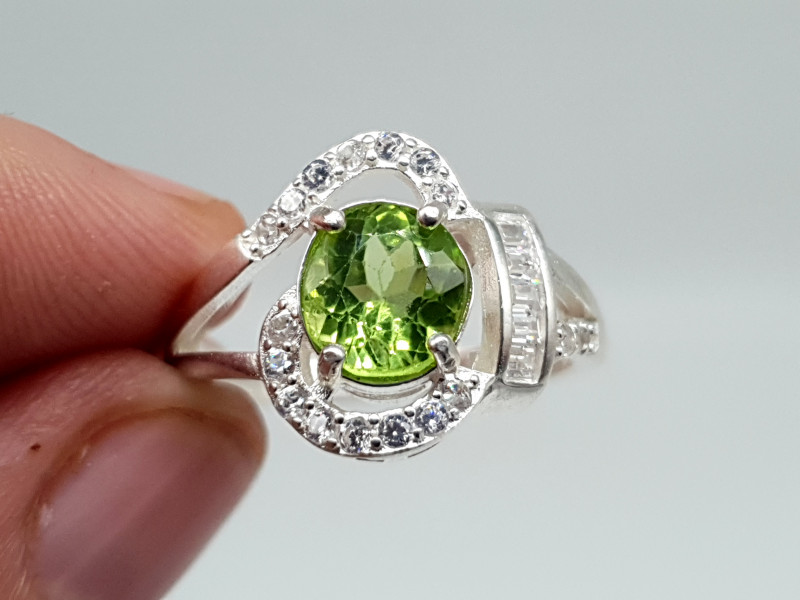
Olivine Price & Value
The most popular type of olivine gemstone to buy is faceted peridot, so let’s look at this olivine’s price-per-carat ranges on average:
Less than 1 carat: $40 to $45 per carat
1 to 2 carats: $50 to $80 per carat
2 to 5 carats: $80 to $130 per carat
5 to 8 carats: $110 to $130 per carat
Over 8 carats: $130 to $150 per carat
Generally, faceted peridot gems verified to be from Myanmar or Pakistan are on the higher end of those prices. The very highest quality peridot gems can be $400 to $450 per carat, though!
Comparatively, synthetic peridot gems (created in a lab but with the same optical and physical properties as natural material) can be up to 40% lower in price per carat.
Faceted tephroite olivines are around $15 to $50 per carat, while tephroite cabochons are about $1 to $2 per carat.
Regular peridot cabochons (not cat’s eye or star) range from about $25 to $190 per carat. Cat’s eye olivine cabochons cost from $20 to $50 per carat usually but go up to $800 per carat.
Average olivine jewelry price ranges are:
Rings: $20 to $1,000
Earrings: $25 to $1,200
Bracelets: $25 to $2,100
Pendant Necklaces: $60 to $900
Now that you’ve bought it, what are some tips for caring for and preserving the beauty of olivine jewelry?
Olivine Care and Maintenance
When caring for your gemstones, remember that there isn’t a standard, universal process for every stone. While peridots are pretty durable, they aren’t indestructible. They can scratch, chip, or shatter if you aren’t careful.
Luckily, olivine gems are pretty easy to clean. Warm, soapy water works best. Wash the gem gently and let it air dry. Avoid ultrasonic or steam cleaners. Their high vibrations and temperatures could damage your stone.
Store olivine gemstones in a cool, dry place away from anything that might scratch or hit it. Avoid exposure to heat, sudden temperature changes, or acid — even keeping peridot against your skin for too long can expose it to acid from your sweat.
We also recommend protective settings for more vulnerable jewelry like olivine rings.
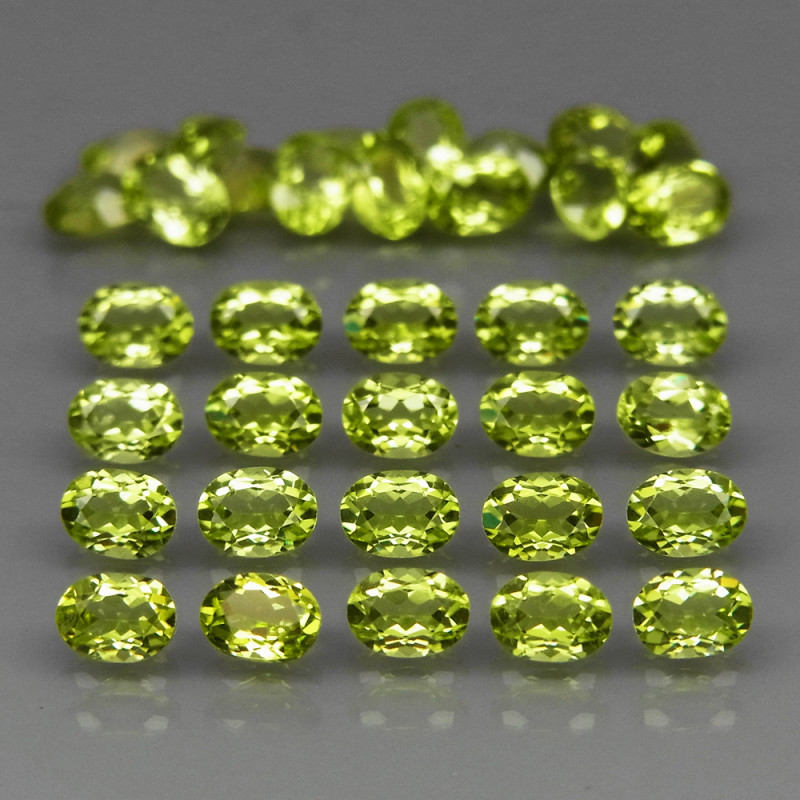
Frequently Asked Questions
Lastly, let’s go over some common queries about olivine:
What are the primary types of olivine gemstones, and how do they differ from each other?
The three primary types of olivine are fayalite, forsterite, and tephroite.
Most olivine minerals, like the gemstone peridot, fall within the series from magnesium-dominant forsterite to iron-dominant fayalite. Often, the term “olivine” for a mineral refers to a stone with a fayalite-forsterite composition — given the formula (Mg,Fe)2SiO4.
Tephroite is a manganese-dominant variety and the manganese-dominant endmember of a series with forsterite and another series with fayalite.
All three olivine minerals share the same olivine structure with orthorhombic crystal symmetry. The difference lies in what kind of silicate they are — ferrous iron (fayalite), magnesium (forsterite), or manganese (tephroite).
Additionally, fayalite-forsterite olivine minerals are more abundant than tephroite olivine minerals.
What are the distinctive physical and optical properties of olivine gemstones?
Compared to other gemstones, some of the most distinctive properties of olivine are its:
Birefringence: Olivine has a higher birefringence (0.035 to 0.052) than most gems.
Hardness: Olivine is usually harder than glass (6 to 7 for olivine vs 5.5 to 6.5 for glass) and other gems like apatite and fluorite.
Relief: A mineral’s “relief” relates to its refractive indices, and olivine has a high relief, meaning its grain boundaries are sharp and distinct.
Coloring: Most olivine is some shade of green (possibly nickel), though many specimens turn greenish-brown to brown from the iron oxidizing.
Speaking of color...
How does olivine's color range vary, and are there any notable color variations?
The most recognizable olivine color is its namesake: olive (yellowish-green). You can see variable green shades, though, with undertones of yellow, gray, and brown.
But olivine minerals don’t just vary in green shades; they also come in other hues like brown, golden-brown, gray, red, black, and even white or colorless.
One notable olivine color variation is the rare color-changing tephroite, which shifts from bluish-gray or grayish-green in daylight to reddish-brown under incandescent light.

What are the primary uses of olivine in jewelry making and other applications?
Olivine jewelry uses are pretty vast. As an August birthstone, many people opt for everyday peridot birthstone jewelry like a faceted peridot ring or simple yet elegant studs. You can also find more lavish options, like custom olivine rings with accent diamonds, peridot tennis bracelets, or statement olivine pendant necklaces.
Outside of beauty, olivine is important in various industries. Some industrial olivine uses include:
Metal manufacturing — Furnace linings, refractory bricks, casting sand, steel purification, and slag conditioner
Climate change reduction — Candidate for carbon sequestration (capturing and storing carbon dioxide to remove it from the atmosphere), e.g. olivine rock used in sustainable semi-paving to reduce carbon dioxide
Geological research — Studying the evolution of life on Earth, e.g. how olivine’s ability to turn formaldehyde into sugars shows that extraterrestrial olivine may have introduced the building blocks of life (the crucial “formose reaction”) to Earth’s first organisms
Volcanic soils — More fertile from easily weathered olivine releasing magnesium and iron
Lasers — Chromium-doped synthetic forsterite as host material for tunable infrared laser
On the topic of synthetic olivine...
How can I differentiate genuine olivine gemstones from synthetic counterparts or imitations?
Starting with synthetic vs natural olivine, there are some surefire scientific methods for identifying synthetic peridot, but these require advanced knowledge of mineralogy.
Overall, synthetic olivine will always be more pure than natural olivine, which always contains impurities to some degree. A lack of any inclusions or imperfections — make sure you check with a microscope — is a good sign that your olivine is synthetic.
Unlike synthetic counterparts, imitations (simulants) do not have the same optical and physical properties. Instead, they merely resemble olivine.
Here are some common olivine imitations and how to distinguish them from real olivine:
Synthetic Spinel: Higher hardness (7.5-8 on Mohs scale) than olivine
Synthetic Corundum: Higher hardness (9 on Mohs scale) than olivine
Glass: No birefringence, so only refracts a single beam of light through it
Tourmaline: Trigonal crystal symmetry, lower density (2.82-3.32), and usually lower refractive index (1.61-1.68)
Yellow-Green Cubic Zirconia: Higher hardness (8.5) than olivine & no birefringence
Epidote: Monoclinic crystal symmetry, often lower birefringence (0.019-0.045), usually found near quartz (while olivine never is)
Sinhalite: Different optic character (biaxial negative, olivine is biaxial positive), stronger pleochroism, and usually shades of yellow to brown
Prasiolite: Trigonal crystal symmetry, lower density (2.60-2.69), and lower birefringence (0.009)
Luckily, simulants are less common for peridot (given its reasonable price point), but it’s always good to be cautious and check for a certificate of authenticity from a reputable organization like GIA or AGS.
Are there any famous or significant pieces featuring olivine gemstones?
Definitely! Some famous olivine gemstones are:
Largest Cut Peridot: A 311.78-carat, mixed cushion-cut peridot displayed at the Smithsonian Museum
Cleopatra’s “Emerald” Collection: Believed by many historians to have actually been peridot
Shrine of the Three Kings (Reliquary of the Magi): Adorned with 200+ carat gems thought to be emeralds but discovered to be peridots; Currently in the Cathedral of Saint Peter and Mary in Cologne, Germany
Russian Royal Peridot: A 192.75-carat peridot that was once in the Russian Royal family, now part of the Russian Diamond Fund & displayed at the Kremlin Armoury in Moscow
Habsburg Peridot Parure: Peridot jewelry set worn by late Archduchess Isabella, Duchess of Teschen (Princess Isabella of Croÿ)
Luckily, you don’t have to be royalty to own olivine jewelry today! This underrated beauty comes at price ranges for any budget.
 Pictured above: Forsterite (var. peridot) displayed at Smithsonian Museum | Image credit: Photograph by Chip Clark, Public domain
Pictured above: Forsterite (var. peridot) displayed at Smithsonian Museum | Image credit: Photograph by Chip Clark, Public domain
Focus On the Good with Olivine!
While the popularity of the olivine gemstone has been inconsistent over the years, its recent resurgence is shining new light on this precious, celestial gem. Not only does it look absolutely beautiful while costing less than other gems, but it literally attracts positive vibes! Who wouldn’t want a little more of that?
Ready to rock the same jewels as the iconic Cleopatra? Shop for olivine today!
Search the Gemstone Encyclopedia
Related Auctions
Related Articles
Originally the Birthstones or gemstones were associated with a zodiac sign or the month of a individuals birth. Find out what your stone is and view the stones we have for sale
8th Feb 2021
There are dozens of quartz and chalcedony gems with various colors and patterns. Learn all about quartz properties and every type of quartz, from amethyst and agate to plasma and phantom quartz!
15th Oct 2020
Hackmanite is a pink to violet sodalite gem known for its unique color-change and luminescence. Learn why hackmanite is special, from its rare qualities to the types of hackmanite jewelry available.
28th Mar 2018
Latest Articles
Tantalite is a group of red, brown, or black minerals containing the rare and valuable element tantalum. Discover the uses, history, prices, and properties of tantalite gemstones in this guide!
11th Nov 2024
Hodgkinsonite is a very rare collector’s gemstone known for its vibrant pink or purple hues, only found in New Jersey, USA. Learn hodgkinsonite’s prices, history, properties, and traits in this guide!
9th Jun 2024
Canasite is a rare mineral usually found as greenish-yellow inclusions in charoite but also known as a purple gemstone. Learn canasite’s history, varieties, properties, and prices in this guide.
27th May 2024
Article Categories
How To's is where you will find helpful articles from gem Rock Auctions on how to cut gemstones, select gemstones and buy gemstones.
9 Articles





